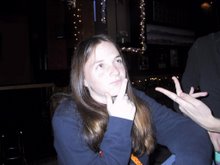
Being the Bob Dylan fan that I am, it was only a matter of time before I saw the biographical film on his life and career, I'm Not There.
I didn't really know what to expect; I knew that there were different versions of Bob Dylan, all sorts of people who don't necessarily look like Dylan at all. But, I did not think it was going to be this abstract and poetic. I thought it was really going to be a biography, but it was less straight-forward and true-to-his-life than I anticipated it would be.
And maybe this is a good thing. It's not another one of those biographical movies like Ray or Janis. It's not a start to finish to understand his life. If you know his story (and his many phases), you will get a lot more out of the movie and will be able to understand what's going on, what symbolizes what, and why certain names were used to portray his character.
Each phase of Dylan's life and career are portrayed by different actors who are completely different:

Marcus Carl Franklin = Woody Guthrie = Young Bob Dylan
This is the African American boy who is portrayed as the talented Bob Dylan who travels the country yet is also some sort of delinquent.
Ben Wishaw = Arthur Rimbaud = Young rebel/poet
This is the black-and-white narrating character who is interviewed throughout the film. He acts as the narrator throughout the movie.
Christian Bale = Jack Rollins = Early '60s Folk Era Dylan
This is the version of Dylan with the attached harmonica and early folksy songs which gained him his most recognition. It is during this period that a character named Alice (based on Joan Baez) talks about Dylan.
Christian Bale = Pastor John = The Born Again Christian
Bale also plays Dylan who converts to Christianity and preaches to others. He is shown in a church singing his gospel song "Pressing On."
Heath Ledger = Robbie Clark = Dylan's personal life and failing marriage
Clark is a fictional actor who portrays Robbie Clark in a film called "Grains of Sand." This character shows Dylan on the road, Dylan falling in and out of love with his life, Dylan's traveling, Dylan's affairs, Dylan's lack of attention with his children, Dylan's pressure as he is attacked by the press, and Dylan's massive change over time with his gained fame. Claire is based on Dylan's first wife Sara Dylan.
Cate Blanchett = Jude Quinn = Dylan's height of fame in the '60s
This is Dylan's most famous look with the frizzy hair, the black-and-white suit, and teh sunglasses. Dylan's fans view him as a sell-out and rebel against him as this persona. He is attacked by the press and fans for turning away from protest music and folk. In this character, Dylan meets Allen Ginsberg and the Beatles.
Richard Gere = Billy the Kid = Dylan's country life in Woodstock and later years
This sequence goes back in time, which puzzled me, but he lives a simple life where he is hiding away from the rest of the world, almost like an outlaw.

I thought that the actors portrayed him very well, especially Cate Blanchett. I saw that she was nominated for and won tons of awards. She deserved it. Even though she is a female playing a male role, she looked exactly like him and got all of his mannerisms and speech patterns down. It was so on that it was entirely eerie. She was my favorite version of Dylan.
The movie was pretty scattered. Many plotlines were happening at once, all representing various time periods of Dylan's life. I was confused at a few parts and still have a few questions about the whole thing. This is definitely a movie that you can watch a few times and understand more and more about it each time you watch it. Those are the best kinds of movies. That must be why this movie was nominated as one of the best films of 2007, within the top ten on many lists.
I still have the following questions, if anyone knows the answers to help me out a bit:
Why was Billy the Kid's time sequence taking place so far back in the past?
Why was Dylan's life portrayed more negatively, as if more people hated him than loved him? Why did he receive so much negative criticism and hardships than portrayed as good?
Why was one of his personas, Robbie Clark, portrayed as a film actor?
Why was Dylan given two daughters to represent his children when he had many more children of both gender?
Why were certain names selected?
Why was Dylan's childhood noted as traveling for fame when he did not go out in search of it until after high school?
Why was he portrayed as an African American child?
I did think that the film was very well done. It was very artistic, as Bob Dylan would have wanted. I would like to see more movies like this. It was just unbelievable.
Also, the soundtrack is fantastic. So many good artists came together to pay tribute to Dylan with many of his great songs. Excellent artists who contribute on the album are Eddie Vedder, Mason Jennings (who sounds almost identical to Dylan), Sonic Youth, Cat Power, Karen O, Jeff Tweedy, Willie Nelson, Jack Johnson, the Black Keys, and of course, Bob Dylan and the Band. Do check it out.
For more information on the movie, Wikipedia has an excellent cite detailing the film.
So, what did you think of I'm Not There?


No comments:
Post a Comment